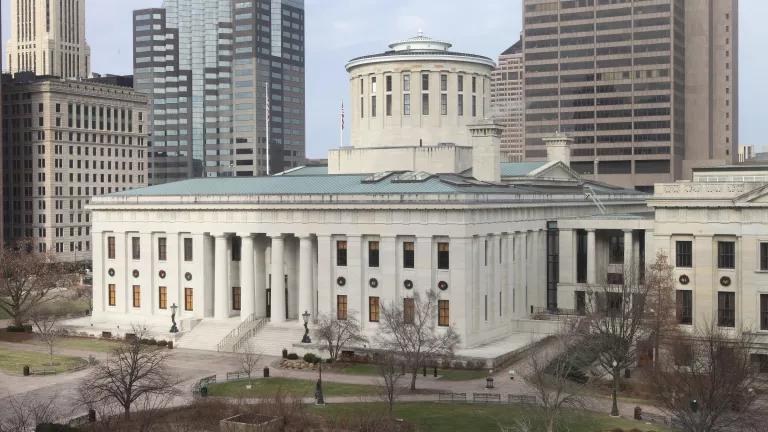Energy Efficiency: Ohio's Hospitals and Low-Income Residents
Ohio's Hospitals and low-income residents have benefit greatly from energy efficiency programs. Still, Ohio lawmakers may choose to eliminate these programs and increase the energy burden—and electric bill—for both.

The Ohio Statehouse in Columbus
Just this morning, I sat in on an energy efficiency stakeholder collaborative meeting with American Electric Power in Columbus. These collaborative groups have been in place with our Ohio utilities since 2008 when Ohio passed a law to help energy consumers in Ohio reduce their electric bills through programs that help them to reduce unintentional energy waste. I provided an explainer on Ohio’s energy efficiency law in a previous blog—found here—where I address some of the most common questions and misconceptions around the value of energy efficiency programs being offered through our regulated utilities.
As the Ohio General Assembly races toward potential action to address the negative consumer impacts of House Bill 6, I wanted to share a few highlights of Ohio’s energy efficiency programs—the way they support low-income customers, hospitals, and our workforce—that I hope will be considered in these final hours.
Benefits to Low-Income Electricity Customers
A presenter from Ohio Partners for Affordable Energy started off the meeting by recapping the value of energy efficiency programs for Ohio’s most vulnerable citizens. Low-income customers in the AEP service territory saved over 888 million kWhs through these utility-sponsored efficiency programs since 2009. By enabling customers to receive central AC upgrades, heat pump installations, outdated refrigerator and freezer replacements, lighting upgrades, water heater retrofits and other measures, energy efficiency programs saved customers energy and therefore money.
85,000 customers saved over $111 million dollars over the life of the measures they installed in their homes since 2009. This is an overwhelming net benefit as those programs cost only $81 million over that same period of time. About 35% of AEP Ohio’s customers are eligible for this low-income program, representing over 450,000 Ohio households, and these low-income programs offered through AEP have only reached 19% of this customer segment to date. There is plenty more to be done. In this time of economic crisis, hundreds of thousands of Ohioans are already behind on their energy bills. It is inexcusable to back down now on cost-effective programs that would help Ohioans save money and avoid utility disconnection.
These programs are making a meaningful difference for customers. During the presentation, a customer feedback letter from a program participant shared that:
“Unfortunately, I am one of those Ohioans in dire straits. The amazing [energy efficiency] crews have given me hope and more enthusiasm for taking not only more care of my home but of myself as well. The work that these guys did truly has changed me. My old refrigerator was 28 years old and stopped running. It leaked water through the ice maker. I did my best to take care of the guys while they were working really hard. They were very professional and if I had money, I would hire them back to my home to do even more work. I am blessed that you came into my life and for that, I am truly truly grateful.”
Benefits to Ohio’s Hospitals
The Ohio Hospital Association was next to present and offered a similarly compelling narrative. There are 16 Ohio hospitals that have been awarded the ENERGY STAR designation for their efforts to reduce energy waste throughout their systems, many of them being repeat award winners, but with 4 of them having recently received this designation for the first time. This award-winning progress shows that there are ample opportunities to continue helping Ohio’s hospitals reduce their energy cost burden through targeted efficiency investments in partnership with our regulated utilities.
In 2019, Ohio led all other states in the country in ENERGY STAR certified hospitals, and is likely to do so again in 2020. The Ohio Hospital Association presentation highlighted the fact that all types of hospitals participate in energy waste reduction efforts. This includes large hospital systems, rural hospitals, and even military base hospitals have been ENERGY STAR certified: in 2019 Wright-Patterson Air Force Base Medical Center became the first military based medical center in the United States to receive Energy Star certification.
It was mentioned by the hospital association’s representative that Ohio’s hospitals have had to absorb massive financial losses in 2020 due to the ongoing pandemic. Offering some relief for this, Ohio’s Hospitals have saved over $20 million in energy savings over the last 4 years in AEP Ohio territory alone due to the rebates offered through the efficiency programs. This a reduction of more than 42 million kWhs.
There remains ample opportunity to continue helping our hospitals reduce energy waste, better preparing them to serve us in our most difficult times. None of us want to be in a hospital, but we’re so grateful when these critical facilities are there to serve us in our time of need. Energy efficiency has been an important tool to help protect our hospitals—and other critical facilities around the state—and our state policies should recognize how critically important this energy efficiency work has been.
Ohio Must Continue to Invest in Efforts to Reduce Energy Waste
Of the many terrible aspects of House Bill 6, the worst impact may have been the elimination of our energy efficiency programs. These programs have been overwhelmingly successful, continually saving Ohio electricity customers more than they cost, as required by law. And they do so while creating good jobs for Ohioans. As I’ve written about previously, over 11,000 military veterans are working in Ohio’s clean energy economy, representing 11% of Ohio’s total clean energy workforce—these jobs are at risk without action from our legislature.
Our recovery from the economic impacts of the pandemic is far from complete and our labor market remains on shaky ground with unemployment still higher than it was at this time last year. Our legislature shouldn’t act to take good jobs away from Ohioans at this crucial moment.
As Ohio’s lame duck legislative session starts to come to a close, lawmakers will be making a decision of whether to continue the programs or maintain the elimination of them. The case could not be clearer. Energy efficiency is an incredible tool for our state that must be allowed to continue.



